Advertisements
Advertisements
प्रश्न
Find the potential difference Va – Vb in the circuits shown in the figure.
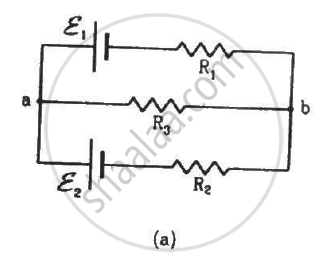
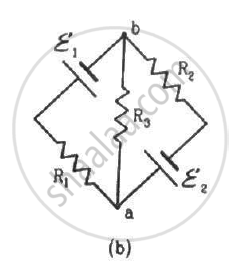
उत्तर

Applying KVL in loop 1, we get:-
\[i_1 R_2 - E_2 + \left( i_1 + i_2 \right) R_3 = 0\]
\[( R_2 + R_3 ) i_1 + R_3 i_2 = E_2 ...........(1)\]
Applying KVL in loop 2, we get:-
\[i_2 R_1 - E_1 + \left( i_1 + i_2 \right) R_3 = 0\]
\[\left( R_1 + R_3 \right) i_2 + R_3 i_1 = E_1 .............(2)\]
Multiplying equation (1) by (R1+R3) and (2) by R3 and then subtracting (2) from (1), we get:-
\[i_1 = \frac{E_2 \left( R_1 + R_3 \right) - E_1 R_3}{\left( R_1 R_2 + R_2 R_3 + R_3 R_1 \right)}\]
Similarly, multiplying equation (1) by R3 and (2) by (R1+R3), and then subtracting (2) from (1), we get:-
\[i_2 = \frac{E_1 \left( R_2 + R_3 \right) - E_2 R_3}{\left( R_1 R_2 + R_2 R_3 + R_3 R_1 \right)}\]
From the figure,
\[V_a - V_b = \left( i_1 + i_2 \right) R_3 \]
\[ \Rightarrow V_a - V_b = \left[ \frac{E_1 R_2 + E_2 R_1}{\left( R_1 R_2 + R_2 R_3 + R_3 R_1 \right)} \right] R_3 \]
\[ \Rightarrow V_a - V_b = \frac{\frac{E_1}{R_1} + \frac{E_2}{R_2}}{\frac{1}{R_1} + \frac{1}{R_2} + \frac{1}{R_3}}\]
(b) The circuit in figure b can be redrawn as shown below:-
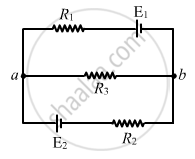
We can see that it is similar to the circuit in figure a and, hence, the answer obtained will be same.
APPEARS IN
संबंधित प्रश्न
In the following potentiometer circuit, AB is a uniform wire of length 1 m and resistance 10 Ω. Calculate the potential gradient along the wire and balance length AO (= l).
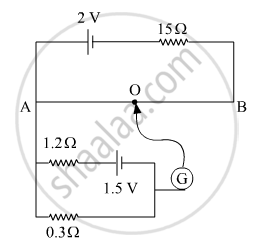
When 5 V potential difference is applied across a wire of length 0.1 m, the drift speed of electrons is 2.5 x 10-4 m/s. If the electron density in the wire is 8 x 1028 m-3, calculate the resistivity of the material of the wire.
In a series LCR circuit, what is the phase difference between VL and VC where VL is the potential difference across the inductor and V c is the potential difference across the capacitor?
Why are Si and GaAs preferred materials for solar cells?
Why is potentiometer preferred over a voltmeter for comparison of emf. of cells?
The emf of a cell is always greater than its terminal voltage. Why? Give reason.
The potential difference between the terminals of a battery of emf 6.0 V and internal resistance 1 Ω drops to 5.8 V when connected across an external resistor. Find the resistance of the external resistor.
The following figure shows a part of a circuit. If a current of 12 mA exists in the 5 kΩ resistor, find the currents in the other three resistors. What is the potential difference between the points A and B?

In the circuit shown in the figure, ε1 = 3 V, ε2 = 2 V, εa = 1 V and r1 = r2 = r3 = 1Ω. Find the potential difference between the points A and B and the current through each branch.

A voltmeter of resistance 400 Ω is used to measure the potential difference across the 100 Ω resistor in the circuit shown in the figure. (a) What will be the reading of the voltmeter? (b) What was the potential difference across 100 Ω before the voltmeter was connected?

If a constant potential difference is applied across a bulb, the current slightly decreases as time passes and then becomes constant. Explain.
A copper strip AB and an iron strip AC are joined at A. The junction A is maintained at 0°C and the free ends B and C are maintained at 100°C. There is a potential difference between _______________ .
(a) the two ends of the copper strip
(b) the copper end and the iron end at the junction
(c) the two ends of the iron strip
(d) the free ends B and C
The potential difference across the terminals of a battery of emf 12 V and internal resistance 2 Ω drops to 10 V when it is connected to a silver voltameter. Find the silver deposited at the cathode in half an hour. Atomic weight of silver is 107.9 g mol−1.
A potential difference of 220 V is maintained across 12000 Ω rheostat. Then voltmeter V has a resistance of 6000 Ω and point C is at one fourth the distance from a to b. Then the reading of voltmeter is ______.
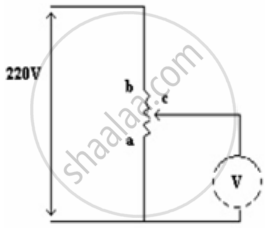
Two sources of equal e.m.f are connected to an external resistance R in series. The internal resistance of the two sources are R1 and R2 (R2 > R1) If the potential difference across the source having internal. resistance R2 is zero, then ______.
